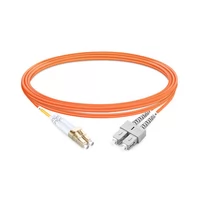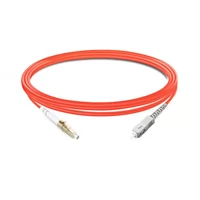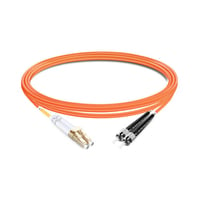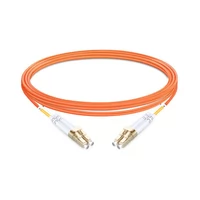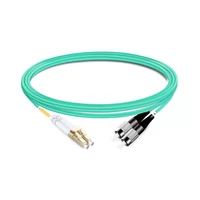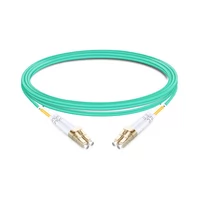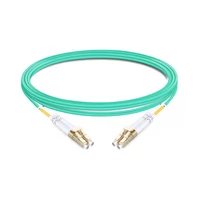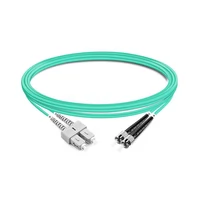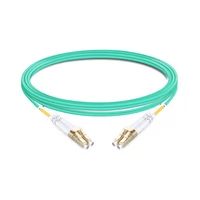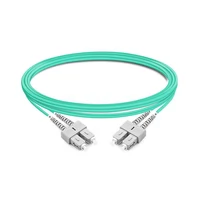Table of Contents
ToggleThe transmission rate and bandwidth of multimode optical fibers
When the geometric size of the fiber (mainly the core diameter d1) is much larger than the wavelength of light (about 1 micron), there will be dozens or even hundreds of propagation modes in the fiber. Different propagation modes will have different propagation speeds and phases, so time delays will occur after long-distance transmission, resulting in wider optical pulses. This phenomenon is called modal dispersion of optical fiber, also known as intermodal dispersion.
There will be a bandwidth (channel bandwidth) parameter in the parameters of multimode fiber, the unit is MHz·km, and sometimes it is asked whether the transmission rate of multimode fiber reaches 200 Mbit/s? How to understand the relationship between the two?
Let’s first understand the bandwidth of multimode fiber.
Usually, the information capacity of multimode fiber is measured by the product of bandwidth and length. Why is the unit not MHz, but MHz·km? First of all, we must understand the characteristics of multimode fiber: the additional group delay, intermodal dispersion, material dispersion, waveguide dispersion, etc. in the process of transmitting optical waveguide signals in multimode optical fiber led to signal distortion. Among them, intermodal dispersion is the decisive factor for bandwidth. The material dispersion and waveguide dispersion are usually negligible in multimode fiber, but they significantly impact single-mode fiber.
The above-mentioned factors will cause that the transmission length of the optical waveguide signal is inversely proportional to the bandwidth when the signal is transmitted in the multimode fiber. Generally, the longer the transmission length, the lower the transmission bandwidth. The unit of MHz·km is to describe the capacity that multimode fiber can transmit within 1 KM (provided that the signal does not fail). Fiber length is an iconic physical parameter. Once the distance is determined, the fiber selection range can be narrowed according to the user’s current or future bandwidth requirements. Therefore, it is meaningless to simply say the actual bandwidth of the multimode fiber, and the length must be added to ensure that the signal does not fail, so the unit becomes MHz·KM. For example, if the bandwidth is 600 MHz·KM, its bandwidth is only 300 M at a place of 2 KM. For step-index multimode fiber, the influence of various factors makes its bandwidth-length product limited to 20MHz·KM; for gradient-index fiber, its bandwidth-length product can be as high as 2.5GHz·KM; and for single-mode fiber, due to factors such as small dispersion and narrow light source spectrum width, it can be considered that its transmission bandwidth is infinite. Studies have shown that for a short wavelength of 0.85 μm, if the root-mean-square spectral width of the light source is 20 nm, the total bandwidth of the fiber in the best case is only 1 GHz km; For 1.30 μm wavelength, if the profile index is well controlled, the highest bandwidth can exceed 10 GHz·km.
(Remarks: For now, the root-mean-square spectral width of LED (light-emitting diode) is about 5% of the central wavelength. For example, assuming that the emission peak wavelength of LED is 850nm, its typical spectral width should be 40nm, that is most of the power of the emitted light concentrates in the wavelength range of 830~870nm. The spectral width of LD (semiconductor laser) light source is much narrower, among which the typical spectral width of multimode LD is 1~2 nm, while the typical spectral width of single mode LD is only 0.0001nm.)
The transmission rate of multimode fiber is related to the bandwidth of multimode fiber. First of all, the data transmission rate (also known as code rate, bit rate or data bandwidth) describes the number of bits of data code transmitted per second in communication. The unit is bit/second, which can be recorded as bit/s=b/s=bps. The relationship between the channel bandwidth and the data transmission rate can be described by the Nyquist criterion and Shannon’s law.
The Nyquist criterion points out that if the time interval is π/ω (ω=2πf–>2f=w/π), and the narrow pulse signal is transmitted through the ideal communication channel, there will be no mutual interference between the preceding and following symbols. Therefore, the relationship between the maximum data transmission rate Rmax (in bps) of binary data signals and the communication channel bandwidth B (B=f, in Hz) can be written as: Rmax=2f. For binary data, if the channel bandwidth B=f=200MHz, the maximum data transmission rate is 400Mbps, and the rate can be increased by N times in multi-ary system. The Nyquist theorem describes the relationship between the maximum data transmission rate of a limited-bandwidth, noise-free channel and the channel bandwidth.
Shannon’s theorem describes the relationship between the maximum transmission rate of a channel with limited bandwidth and random thermal noise, channel bandwidth, and signal-to-noise ratio. Shannon’s theorem points out that when transmitting data signals on a channel with random thermal noise, the relationship among the data transmission rate Rmax, the channel bandwidth B, and signal-to-noise ratio S/N is: Rmax=B log2(1+S/N), the unit of Rmax is bps, the unit of bandwidth B is Hz, and signal-to-noise ratio S/N is usually expressed in dB (decibels). If S/N=30(dB), then signal-to-noise ratio can be obtained according to the formula: S/N(dB)=10·lg(S/N), S/N=1000. If the bandwidth B=3000Hz, then Rmax≈30kbps.
Shannon’s Law gives a limit on the maximum data transmission rate for a finite bandwidth, thermally noisy channel. It means that for a communication channel with a bandwidth of only 3000Hz, when signal-to-noise ratio ratio is 30db, no matter the data is expressed in binary or more discrete level values, data cannot be transmitted at a rate exceeding 30kbps.
“OM” stands for optical multi-mode, a standard for multimode fiber to indicate the level of fiber. The bandwidth and maximum distance of different levels of transmission are different, and the differences are analyzed from the following aspects.
Comparison of parameters and specifications of OM1, OM2, OM3 and OM4 optical fibers
- OM1 refers to 50 μm or 62.5 μm core diameter multimode fiber with a full injection bandwidth of 850/1300 nm and above 200/500 MHz·km;
- OM2 refers to the 50 μm or 62.5 μm core diameter multimode optical fiber with a full injection bandwidth of 850/1300 nm and above 500/500 MHz·km;
- OM3 is a 50 μm core diameter multimode fiber optimized by 850 nm laser. In 10 Gb/s Ethernet using 850 nm VCSEL, the fiber transmission distance can reach 300 m.
- OM4 is an upgraded version of OM3 multimode optical fiber, and the optical fiber transmission distance can reach 550 m.
Comparison of parameters and specifications of OM1, OM2, OM3 and OM4 optical fibers
| Type | Fiber diameter(μm) | Optical fiber type | 1 GigabitEthernet 1000BASE-SX | 1 GigabitEthernet 1000BASE-LX | 10GbpsEthernet 10GBASE | 40Gbps Ethernet 40GBASE SR4 | 100Gbps Ethernet 100GBASE SR4 |
|---|---|---|---|---|---|---|---|
| OM1 | 62.5/125 | multimode | 275m | 550m | 33m | not supported | not supported |
| OM2 | 50/125 | multimode | 550m | 550m | 82m | not supported | not supported |
| OM3( laser-optimized) | 50/125 | multimode | 550m | 550m | 300m | 100m(SR4) | 100m(SR4) |
| OM4( laser-optimized) | 50/125 | multimode | 550m | 550m | 400m | 150m(SR4) | 150m(SR4) |
| Single mode | 9/125 | single mode | 5km at 1310nm | 5km at 1310nm | N/A |
Design comparison of OM1, OM2, OM3 and OM4 fibers
- The traditional OM1 and OM2 multimode fibers use LED (Light Emitting Diode) as the basic light source in terms of standard and design, while OM3 and OM4 are optimized on the basis of OM2, making them suitable for the transmission with LD (Laser Diode) as light source;
- Compared with OM1 and OM2, OM3 has higher transmission rate and bandwidth, so it is called optimized multimode fiber or 10G multimode fiber;
- OM4 is re-optimized on the basis of OM3, with better performance.
Comparison of functions and characteristics of OM1, OM2, OM3 and OM4 optical fibers
- OM1: Large core diameter and numerical aperture, with strong light-gathering ability and anti-bending characteristics.
- OM2: The core diameter and numerical aperture are relatively small, which effectively reduces the modal dispersion of multimode fiber, significantly increases the bandwidth, and reduces the production cost by 1/3.
- OM3: The use of flame-retardant outer skin can prevent the spread of flames, prevent the emission of smoke, acid gas and poisonous gas, etc., and meet the needs of 10 Gb/s transmission rate.
- OM4: Developed for VSCEL laser transmission, the effective bandwidth is more than double that of OM3.
Application comparison of OM1, OM2, OM3 and OM4 optical fibers
- OM1 and OM2 have been widely deployed in building applications for many years, supporting Ethernet transmission with a maximum of 1Gb.
- OM3 and OM4 optical cables are usually used in the wiring environment of the data center, supporting the transmission of 10G or even 40/100G high-speed Ethernet.
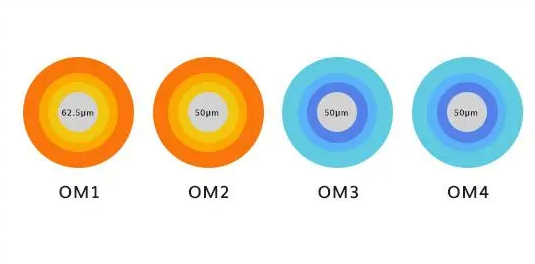
Fiber diameters of om1, om2, om3, and om4
When to use OM3 fiber optic jumper?
OM3 optical fiber is an optical fiber designed to work with VCSEL, conforms to the OM-3 optical fiber specification of ISO/IEC11801-2nd, and meets the requirements of 10 Gigabit Ethernet applications. There are many types of OM3 optical fiber, including indoor type, indoor/outdoor versatility, etc., and the number of cores of the optical fiber ranges from 4 cores to 48 cores. In addition, all applications based on the old multimode 50/125 fiber are supported, including LED light sources and laser light sources.
- The transmission distance of Gigabit Ethernet using OM3 optical fiber system can be extended to 900 meters, which means that users do not need to use expensive laser devices when the distance between buildings exceeds 550 meters.
- Within a distance of 2000 meters, standard 62.5/125μm multimode fiber can be used in various situations within the OC-12 (622Mb/s) rate range, and single-mode fiber will be used otherwise. However, the emergence of OM3 multimode fiber has changed this situation. Since OM3 fiber can increase the transmission distance of Gigabit and 10 Gigabit systems, the use of 850nm wavelength optical modules and VCSEL will be the most cost-effective wiring solution.
- When the link length exceeds 1000 meters, single-mode fiber is still the only choice at present. Single-mode fiber can achieve a transmission distance of 5 kilometers at a wavelength of 1310nm in a gigabit system, and a transmission distance of 10 kilometers in a 10-gigabit system.
- When the link length is less than or equal to 1000 meters, OM3 50μm multimode fiber can be used in the Gigabit system, and single-mode fiber should be used in the 10 Gigabit system.
- When the link length is less than 300 meters, OM3 multimode fiber can be used in any Gigabit and 10 Gigabit systems.
When to use OM4 fiber optic jumper?
For a typical link, the cost of the optical module is very expensive. Although the cost of single-mode fiber is cheaper than multimode fiber, single-mode fiber requires a very expensive 1300 nm optical module, whose cost is about 2-3 times that of an 850 nm multimode optical module. In general, the cost of a multimode fiber system is much lower than that of the single-mode fiber system.
When investing in fiber optic cabling, if we consider increasing the initial investment of some cabling and adopt better multimode fiber, such as OM4 fiber, we can ensure that the current multimode fiber technology can be fully utilized and reduce the overall cost of the current system; When the system needs to be upgraded to a higher rate system, such as 40G and 100G, OM4 can still be used and will save more expenditure.
In a word, when the transmission rate is greater than 1Gb/s, it is a good system choice to adopt multimode fiber. When the system requires a higher transmission rate, the following are our guidelines for choosing OM4 fiber:
- For Ethernet users, in 10Gb/s system transmission, the transmission distance can reach 300m to 600m; In 40Gb/s and 100Gb/s systems, the transmission distance is between 100m and 125m.
- For campus network users, OM4 fiber will support 4Gb/s fiber link length of 400m, 8Gb/s fiber link length of 200m or 16Gb/s fiber link length of 130m.
Summary
Multimode fiber technology has been developed from OM1 multimode to OM4 which supports 10Gbps now, which will make the user’s investment get the most effective return and become the best choice for backbone cabling or fiber to the desktop.
Recommend Reading:
The Ultimate Guide to Multimode Fiber Optic Cable
Related Products:
-
 1m (3ft) Duplex OM1 Multimode LC UPC to SC UPC PVC (OFNR) Fiber Optic Cable
$2.80
1m (3ft) Duplex OM1 Multimode LC UPC to SC UPC PVC (OFNR) Fiber Optic Cable
$2.80
-
 1m (3ft) Simplex OM1 Multimode LC UPC to SC UPC PVC (OFNR) Fiber Optic Cable
$2.90
1m (3ft) Simplex OM1 Multimode LC UPC to SC UPC PVC (OFNR) Fiber Optic Cable
$2.90
-
 1m (3ft) Duplex OM2 Multimode LC UPC to ST UPC LSZH Fiber Optic Cable
$2.80
1m (3ft) Duplex OM2 Multimode LC UPC to ST UPC LSZH Fiber Optic Cable
$2.80
-
 1m (3ft) Duplex OM2 Multimode LC UPC to LC UPC PVC (OFNR) Fiber Optic Cable
$2.80
1m (3ft) Duplex OM2 Multimode LC UPC to LC UPC PVC (OFNR) Fiber Optic Cable
$2.80
-
 1m (3ft) Duplex OM3 Multimode LC UPC to FC UPC PVC (OFNR) Fiber Optic Cable
$2.80
1m (3ft) Duplex OM3 Multimode LC UPC to FC UPC PVC (OFNR) Fiber Optic Cable
$2.80
-
 1m (3ft) Duplex OM3 Multimode LC UPC to LC UPC LSZH Fiber Optic Cable
$3.00
1m (3ft) Duplex OM3 Multimode LC UPC to LC UPC LSZH Fiber Optic Cable
$3.00
-
 1m (3ft) Duplex OM4 Multimode LC UPC to LC UPC PVC (OFNR) Fiber Optic Cable
$3.00
1m (3ft) Duplex OM4 Multimode LC UPC to LC UPC PVC (OFNR) Fiber Optic Cable
$3.00
-
 1m (3ft) Duplex OM4 Multimode SC UPC to ST UPC PVC (OFNR) Fiber Optic Cable
$3.00
1m (3ft) Duplex OM4 Multimode SC UPC to ST UPC PVC (OFNR) Fiber Optic Cable
$3.00
-
 1m (3ft) Duplex OM4 Multimode LC UPC to LC UPC OFNP Fiber Optic Cable
$3.10
1m (3ft) Duplex OM4 Multimode LC UPC to LC UPC OFNP Fiber Optic Cable
$3.10
-
 1m (3ft) Duplex OM4 Multimode SC UPC to SC UPC LSZH Fiber Optic Cable
$3.10
1m (3ft) Duplex OM4 Multimode SC UPC to SC UPC LSZH Fiber Optic Cable
$3.10

